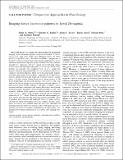Imaging fictive locomotor patterns in larval Drosophila
Abstract
We have established a preparation in larval Drosophila to monitor fictive locomotion simultaneously across abdominal and thoracic segments of the isolated CNS with genetically encoded Ca2+ indicators. The Ca2+ signals closely followed spiking activity measured electrophysiologically in nerve roots. Three motor patterns are analyzed. Two comprise waves of Ca2+ signals that progress along the longitudinal body axis in a posterior-to-anterior or anterior-to-posterior direction. These waves had statistically indistinguishable intersegmental phase delays compared with segmental contractions during forward and backward crawling behavior, despite being ∼10 times slower. During these waves, motor neurons of the dorsal longitudinal and transverse muscles were active in the same order as the muscle groups are recruited during crawling behavior. A third fictive motor pattern exhibits a left-right asymmetry across segments and bears similarities with turning behavior in intact larvae, occurring equally frequently and involving asymmetry in the same segments. Ablation of the segments in which forward and backward waves of Ca2+ signals were normally initiated did not eliminate production of Ca2+ waves. When the brain and subesophageal ganglion (SOG) were removed, the remaining ganglia retained the ability to produce both forward and backward waves of motor activity, although the speed and frequency of waves changed. Bilateral asymmetry of activity was reduced when the brain was removed and abolished when the SOG was removed. This work paves the way to studying the neural and genetic underpinnings of segmentally coordinated motor pattern generation in Drosophila with imaging techniques.
Citation
Pulver , S , Bayley , T , Taylor , A , Berni , J , Bate , M & Hedwig , B 2015 , ' Imaging fictive locomotor patterns in larval Drosophila ' , Journal of Neurophysiology , vol. 114 , no. 5 , pp. 2564-2577 . https://doi.org/10.1152/jn.00731.2015
Publication
Journal of Neurophysiology
Status
Peer reviewed
ISSN
0022-3077Type
Journal article
Description
S.R.P. was supported by a Newton International Fellowship (Royal Society) and a Junior Fellowship (Janelia Research Campus, Howard Hughes Medical Institute). T.G.B. was supported by a Medical Research Council (UK) PhD grant. J.B. was supported by a Henry Dale Fellowship (Royal Society and Wellcome Trust). M.B. was supported by the Isaac Newton Trust.Collections
Items in the St Andrews Research Repository are protected by copyright, with all rights reserved, unless otherwise indicated.

